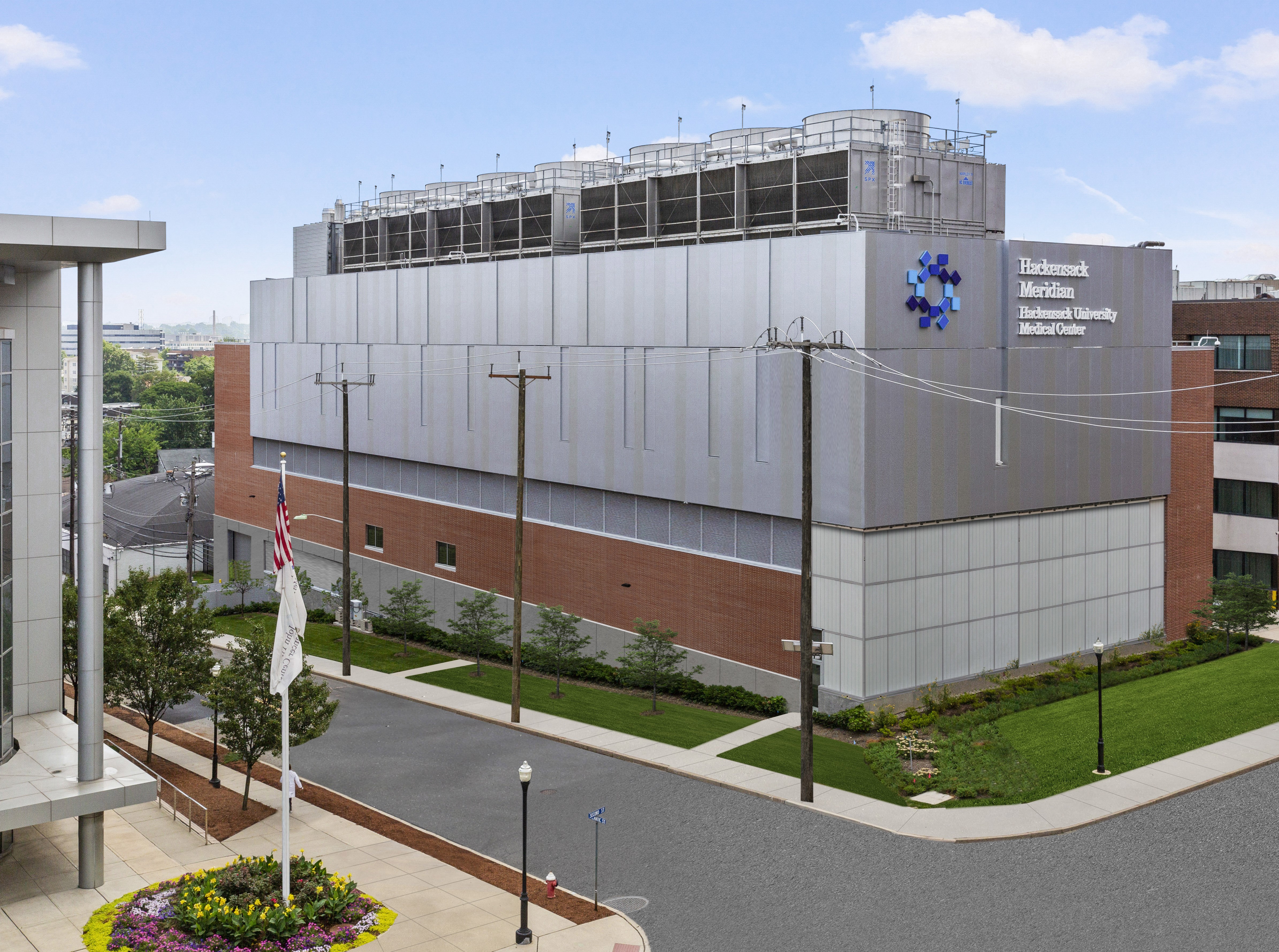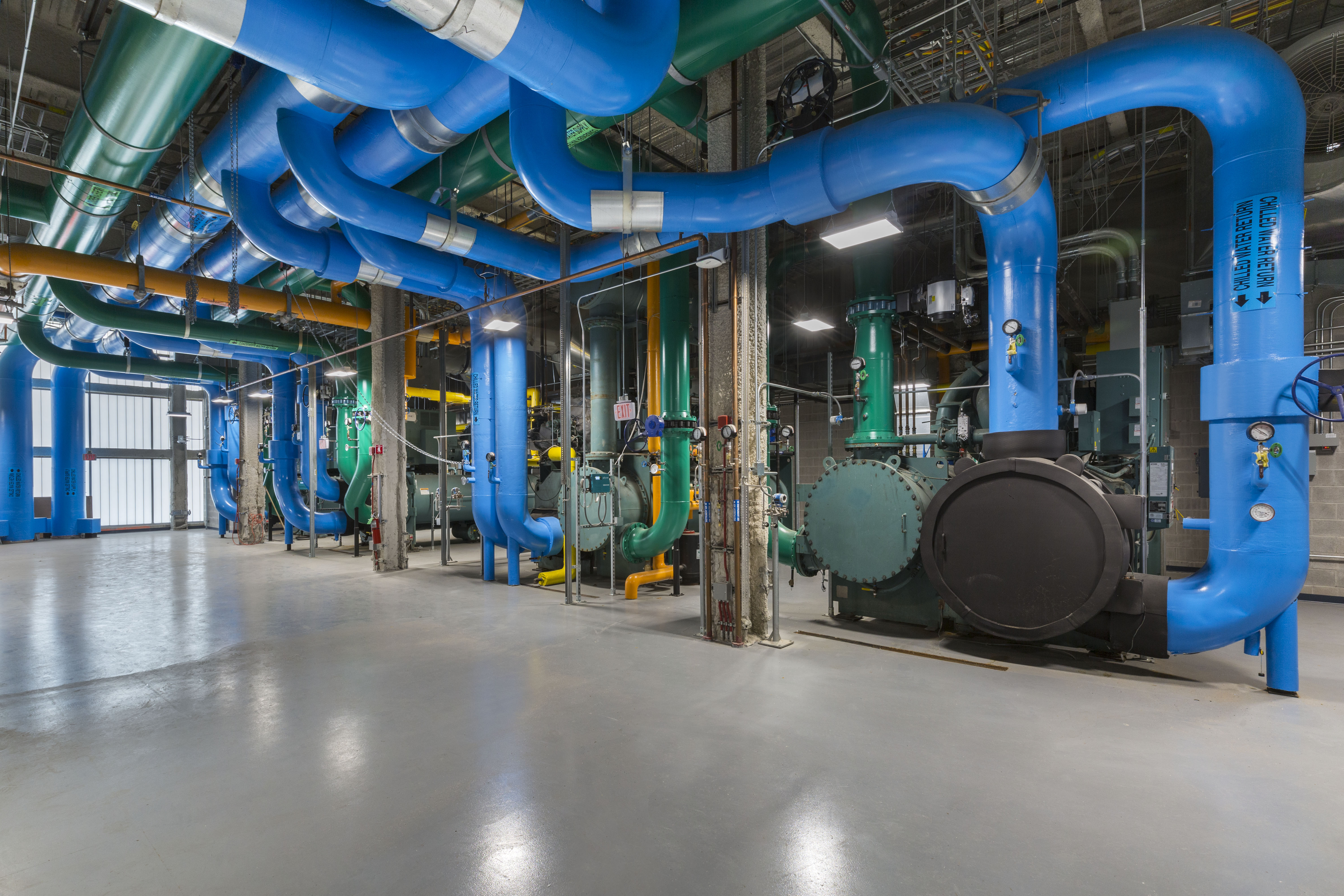Project Location
Hackensack, NJ
United States
Project Owner
Project Type
Hackensack University Medical Center’s new Central Utility Plant is the first in the nation to certify at the Gold level, the first PEER-certified project in New Jersey, and the third medical project to be PEER-certified in the United States.
The catalyst for the design and construction of this new Central Utility Plant, a 45,000 s.f., stand-alone facility that centralizes and consolidates the hospital complex’s existing energy infrastructure, stemmed from the Hackensack Meridian Health network’s desire to expand and grow the acute care services they offer patients, improve the capacity and efficiency of their thermal and electrical utilities, and safeguard the hospital’s mission-critical healthcare services from a potential outage.
Located in a densely-populated urban setting within Hackensack, New Jersey – just seven miles west of New York City – Hackensack University Medical Center is the largest provider of both inpatient and outpatient services in New Jersey, is consistently ranked as a top provider in the state, and was recently named as a Level I trauma emergency department. With 70,000 admissions and 30,000 surgeries taking place annually, the campus and its infrastructure are constantly in operation.
Because the campus is contained within a fully-utilized, nine-block radius, the ability to expand its much-needed acute patient care for an aging population was inhibited. This challenge was compounded by the limitations of the hospital’s aging infrastructure, which were dispersed throughout the campus, to handle any expansion work or the loss of the grid. The campus’ main electrical service was at 90% of its capacity, and the chilled water system was spread out across four plants, with limited space for growth. Likewise, four out of the five boilers within the steam plant were aging, beyond their life expectancy, and were costly to maintain.
The project team, comprised of RSC Architects; Concord Engineering Group; Langan Engineering and Environmental Services, Inc; Reuther + Bowen; EYP, Inc.; Stantec; and Blanchard Turner Construction, proposed the consolidation, relocation, and upgrades to the hospital’s energy infrastructure in order to create space for new patient services and to improve the bandwidth and capabilities of their electrical, chiller, boiler, and generator equipment.
Much like Hackensack University Medical Center’s doctors – who perform complex surgeries to improve patient health – the team of architects, engineers, contractors, and subcontractors worked together collaboratively and meticulously with plant operations and the hospital’s staff to design the new facility, coordinate and phase shut-downs, and relocate and commission equipment within the new plant – all while keeping the hospital fully operational and at full capacity.
The intricate “surgery” that we performed on the “heart and lungs” of the hospital – its vital infrastructure – has replaced 100% of its steam capacity, 100% of its chilled water capacity, its existing 26 kV utility electrical service, utility service transformers, and 13 kV electrical distribution switchgear, while increasing their oxygen capacity and garnering a number of other benefits and savings.
Now, a new 26 kV substation with two larger 20 MVA transformers accommodates future growth and the goals of Hackensack University Medical Center’s master plan, while the plant’s centralized chilled water production has increased the hospital’s firm cooling capacity from 6,600 tons to 9,000 tons. Similarly, the campus is benefitting from replacing their five existing, aging dual-fuel boilers with only a 70,000 pound-per-hour firm capacity to three new dual-fuel water tube boilers with a 120,000 pound-per-hour firm capacity. These boilers are now able to supply steam for the hospital’s sterilization protocols, heating loads, and two steam turbine driven chillers. Three new, fixed 2.5 MW generators, which are sized over and above the current code-required minimum, also offer energy redundancy, keeping power flowing to the hospital in the event of an emergency and keeping patients safe as they undergo critical healthcare procedures.
A new hybrid chilled water plant also ensures that the hospital’s vital services will not be interrupted, should an outage cause the long-term loss of the grid. Because a previous grid outage study indicated that electrical power loss may be a distinct possibility, Hackensack University Medical Center invested in the chilled water plant, equipping it with both electric and steam turbine chillers. Now, in the event of an outage, the plant’s steam boilers can power the steam turbine units to maintain cooling services. Utilizing this hybrid configuration, the hospital can now cover 55% of the campus’ 8,000-ton load using its steam-driven chillers and, depending upon the bus loading, a 1,500-ton chiller can cover 73% of the chilled water load using a manual transfer switch.
Two 2 MW rental generators with quick connects were also incorporated into the plant’s design in order to increase the chilled water generation to 93% of the campus’ load. This arrangement can be used during an extended utility outage, regardless of the emergency bus loading.
As Mark D. Sparta, FACHE, President, Northern Region of Hackensack Meridian Health notes, “Facilities like our Central Utility Plant really serve as the lifeline of our campus, and allow our world-class doctors and nurses to provide the life-saving services that our patients depend on. Achieving and receiving GBCI’s PEER certification validates the environmental resiliency and improvements this plant offers by enabling our hospital to provide advanced patient care and to serve our community when they need us most.”


